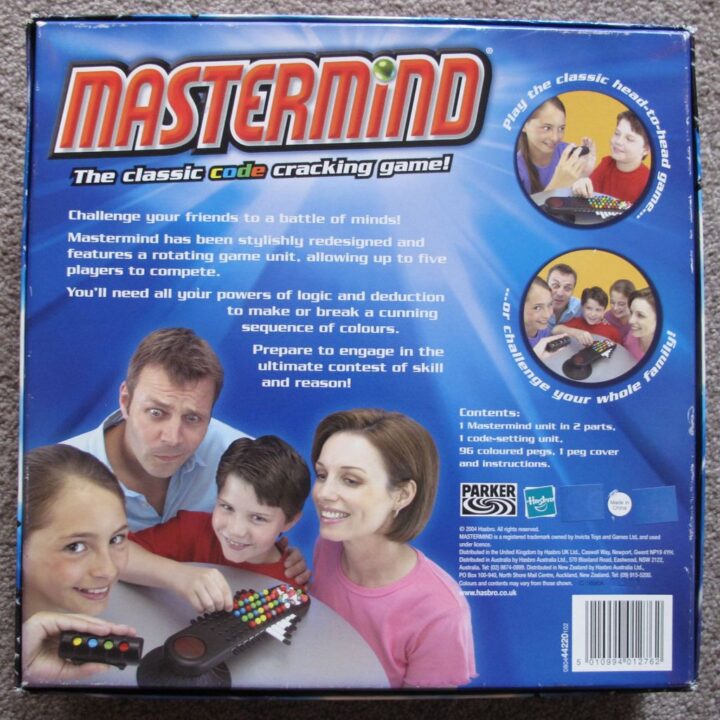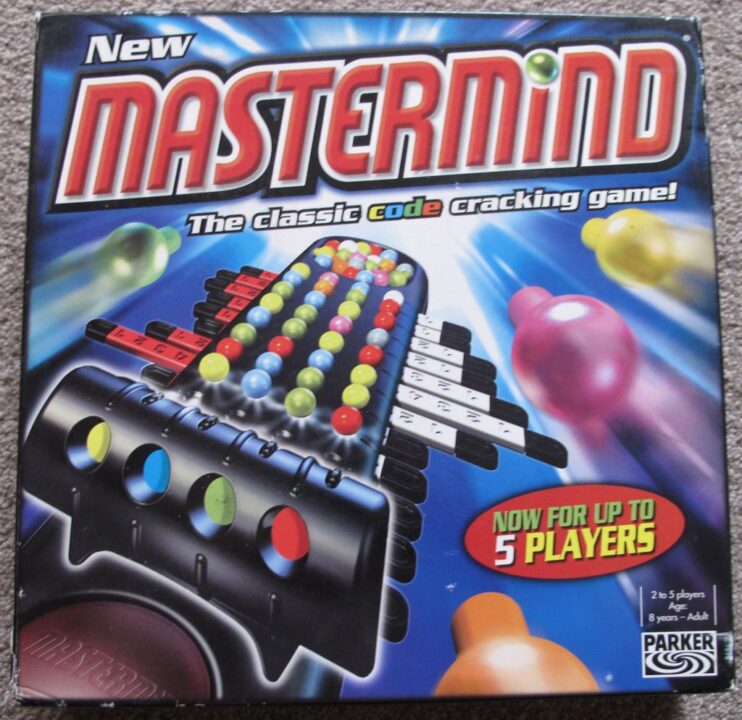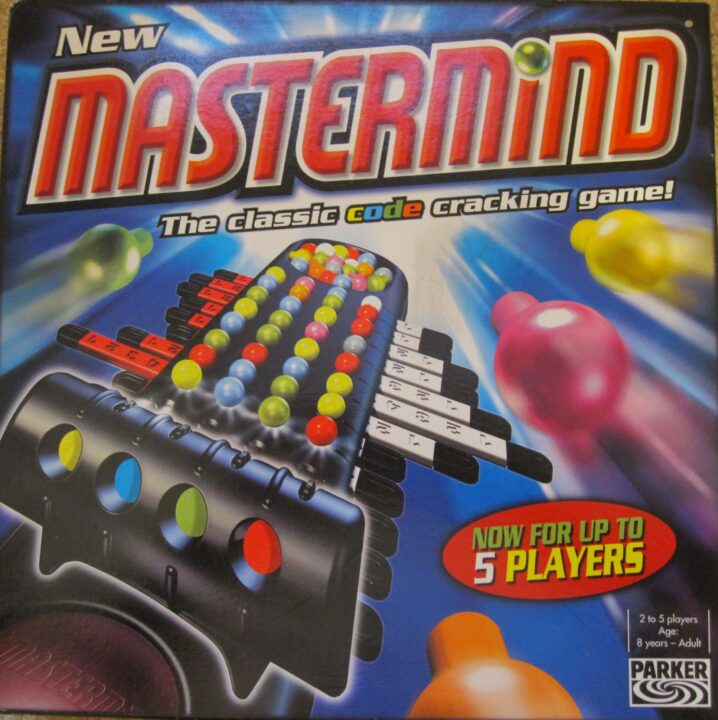Welcome to my review of Mastermind, the classic board game that pits your wits and deductive skills against a secret code. Before you think it’s just another game on the shelf, let me tell you, my friends and I have spent countless evenings trying to outsmart each other with this one. It’s all about clear rules, mental gymnastics, and a good dose of strategy. But is it just skill, or does luck play a sneaky role? Will you get bored or end up coming back for more? Let’s crack it open and see!
How It Plays
Setting Up
First, one player secretly chooses a combo of four colored pegs and hides it behind the screen. The other player grabs a handful of pegs to prepare for guessing.
Gameplay
The guesser tries to figure out the secret combo by placing pegs in the rows. After each guess, the code maker provides feedback using small black and white pegs. Black means a correct color in the right spot, while white means a correct color in the wrong spot.
Winning the Game
To win, the guesser has to crack the code in ten tries or less. If successful, they win bragging rights (and maybe a cookie!). If not, the code maker gets to gloat until the next round!
Want to know more? Read our extensive strategy guide for Mastermind.
Unraveling Mechanics and Rules: Mastermind’s Brain-Bending Prowess
Ah, Mastermind! The game that turns your living room into a battlefield of deduction and wits. Picture this: two players, one with a code and the other trying to crack it. The mastermind, no pun intended, sets up a sequence of colored pegs, hidden behind a nifty little shroud like a magician guarding secrets. The decoder’s job is to guess the sequence with the fewest tries possible.
The mechanics are simple, yet they pack a cerebral punch. You make a guess, and the mastermind hands you feedback using smaller pegs. A black peg means you’ve got the right color in the right spot. A white peg says you’ve hit the right color but in the wrong spot. The rest is up to your brain cells to decipher and adjust. Pretty straightforward, but oh, the mental gymnastics!
Let’s talk rules clarity. I once tried introducing Mastermind at a family game night. My uncle, bless his heart, kept confusing the feedback pegs—claiming they were just overly decorated tic-tac-toe pieces. But give it a round or two, and even he was second-guessing his claims. The instruction booklet is a gem, sticking to the essentials without burying you in jargon. It’s like a well-done burger—satisfying, no frills, and leaves you full of knowledge.
Crucially, Mastermind excels in making sure players are never in the dark, except literally when the code is shrouded. The feedback loop is so reliable, you could set your watch by it; clear, precise, and somewhat comforting. But wait, my friends, the storyline only thickens when we leap into Player Skill versus Luck Balance, where the juicy bits really start to sizzle! Stay tuned.

Player Skill vs. Luck Balance in Mastermind
Let me tell you, if I had a nickel for every eye roll I’ve given when losing a game to pure dumb luck, I’d be a millionaire. Mastermind is a fantastic game for those who pride themselves on outsmarting their friends. This classic game is all about skill, logic, and deduction. There’s no dice rolling or card shuffling to blame when things go south. If you lose, it’s because your friend Dan is a secret coding savant you never knew about. (Dan, if you’re reading this, well played.)
In Mastermind, one player creates a hidden code using colored pegs, and the other tries to crack it. You get feedback after each guess, so it’s all about interpreting that feedback accurately. But unlike some other games, there’s minimal room for error. Trust me, I’ve felt the sting of being just one peg off! This emphasis on skill over luck makes Mastermind an excellent choice for players who love a good mental workout.
Players who focus, observe their opponent’s patterns, and have patience tend to thrive in Mastermind. However, if you’re hoping to rely on Lady Luck, you might want to sit this one out. It’s a refreshing break from those luck-driven games where you don’t even know what just happened, and somehow grandma won (again).
Next up, we shall uncover the secrets of how often we can play Mastermind without growing tired of it, and why Dan always insists on being the codemaker!

Replayability and Variety of Matches in Mastermind
Ah, Mastermind—a game that’s like guacamole: you only need a few ingredients, but it’s always a hit. One thing that keeps bringing me and my friends back to this classic is its replayability. Now, you might say, “Jamie, how many color code combinations can one endure?” Well, my friend, that’s exactly the charm of Mastermind.
The game relies on a simple yet devious mechanic. With over 1,000 different code combinations possible, each session feels like an exciting new puzzle. No two matches are exactly alike, unless one of your friends is unimaginative, of course. But hey, we all have that one friend. For game nights, it’s the go-to when we want something quick yet mentally engaging. It’s like how a bowl of popcorn always seems to vanish faster than you can say ‘more butter.’
Another feather in Mastermind’s cap is how it challenges both the code maker and the guesser. This shared responsibility makes the game feel balanced. You never know if you’re going to be the villain concocting impossible codes or the frustrated detective cracking them. That variety keeps things spicy, sort of like trying to perfect a secret family recipe.
Mastermind never overstays its welcome. It’s like the perfect episode of your favorite sitcom—a complete story in a short time, leaving you wanting more. Next, let’s get into the nuts and bolts, or shall I say plastic pegs, of what makes this game tick: the component quality and game design.
Mastermind: Quality Components and Thoughtful Design
Ah, Mastermind. This game has a way of transporting me back to the days when I’d spill the tiny pegs all over the floor at least once per session. Remember when you were a kid and some toys just felt like they might fall apart if you breathed on them too hard? That’s not the case here. Mastermind’s components are solid, built to survive the apocalypse—or at least a good round of roughhousing kids.
The pegs are satisfyingly chunky, making them easy to handle even for those of us with clumsy fingers. And the board itself? It’s a sturdy piece of kit, designed for many years of strategizing over the table. I’ve got a friend who swears his original set is still as good as new, despite a few coffee spills and one unfortunate incident involving a cat. It’s like the board is saying, “Bring it on!”
The game’s design is sleek and minimalistic, which means less clutter and more focus on outsmarting your opponent. The colors are vibrant but not headache-inducing, and it’s got this satisfying click when you place the pegs. Anyone else addicted to that sound? Just me?
Overall, if you want a game that’s as durable as it is entertaining, Mastermind should be on your shelf. I highly recommend it, as it scores top marks in both build and fun!
Conclusion
Mastermind is a strategic gem, perfect for those seeking a brainy challenge. With clear rules and a focus on skill, it’s a joy for strategy lovers. The sturdy components and endless code combos make it a game you’ll return to. If you’re after a game with minimal luck involvement, Mastermind checks all the right boxes. This concludes our review, and I hope it helps you decide if this classic should be part of your collection!


